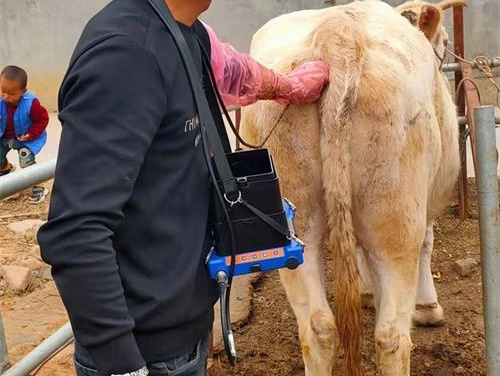As any dairy farmer knows, reproductive health is at the heart of a productive herd. When a cow isn’t cycling properly, or when postpartum recovery doesn’t go as planned, everything from milk yield to future pregnancies is at stake. And while traditional rectal palpation and hormone tests still have their place, many farms are turning to something faster, clearer, and more precise: portable ultrasound.

Across modern dairy operations—large and small—portable ultrasound systems are quietly changing how we detect, manage, and even prevent uterine disorders in cows. They’re not just a high-tech luxury anymore; they’re a practical necessity.
The Daily Reality of Uterine Health in Dairy Cows
Uterine issues aren’t rare. In fact, they’re among the top causes of reproductive inefficiency in dairy cattle. Conditions like endometritis, retained placenta, metritis, pyometra, or a delayed uterine involution can silently compromise fertility long before any visible signs appear.
Many of these conditions can develop postpartum, especially in high-producing cows that experience metabolic stress, negative energy balance, or calving complications. Without effective monitoring, the problem often goes unnoticed until it’s too late—and by then, you’re looking at longer calving intervals, reduced conception rates, or even culling.
Why Portable Ultrasound?
Veterinary ultrasound isn’t new. What’s changed is how compact, 手頃 な 価格, and easy-to-use modern portable systems have become. For vets and trained farm technicians, this means they can walk right into the pen or milking parlor, scan the cow on-site, and get an immediate picture of the uterine environment—all without needing a full exam room or dragging animals to the chute unnecessarily.
Unlike manual palpation, which relies heavily on experience and gives limited internal detail, ultrasound provides visual confirmation of:
-
Fluid accumulation
-
Uterine wall thickness
-
Presence of pus or debris
-
Fetal remnants or placental retention
-
Abnormal structures (e.g., 嚢 胞, abscesses)
The result? More accurate diagnosis, faster treatment decisions, and fewer reproductive surprises down the line.
Monitoring Postpartum Recovery
The weeks following calving are critical. Normally, the uterus should shrink back to its non-pregnant size and clear out any residual fluids within 30–40 days. But when involution is delayed, it becomes a breeding ground for infection.
With portable ultrasound, it’s easy to follow up at different stages:
-
Day 10–15 postpartum: Check for early uterine involution and retained fetal membranes.
-
Day 30–35 postpartum: Ensure no abnormal fluid or endometrial thickening persists.
-
Around first heat: Confirm a clean uterus and presence of functional ovarian structures.
Consistent monitoring helps catch silent infections that would otherwise reduce conception rates during the first insemination cycle.

Spotting the Subtle Cases
Some of the most common uterine disorders don’t come with obvious clinical symptoms. Take subclinical endometritis, for example. Cows may show normal behavior, regular estrous cycles, and yet quietly fail to conceive cycle after cycle.
A quick ultrasound scan can reveal:
-
Slightly increased echogenic fluid
-
Thickened endometrium
-
Uneven uterine tone
These subtle changes often get missed with rectal palpation. Once diagnosed, a short course of antibiotics or intrauterine infusion can correct the issue before it spirals into long-term infertility.
Keeping It Practical on the Farm
On many farms, portable systems are used right in the milking parlor or feed alley. Devices like the BXL-V50—known for its waterproof casing, long battery life, and real-time image quality—allow one-handed operation, even when gloves are on and the environment is less than ideal.
Because it works off a rechargeable battery and displays high-resolution B-mode images, it’s ideal for spotting uterine irregularities without taking cows out of their routine. Vets or trained herd managers can conduct regular scans during herd checks, especially in cows that are slow to return to estrus.
Over time, this leads to better breeding records, tighter calving intervals, and lower cull rates.
Preventive Care, Not Just Diagnosis
One of the biggest mindset shifts with portable ultrasound is moving from reactive to proactive care. Instead of waiting for a cow to miss two or three heats, farms now scan at predetermined intervals:
-
At 30 days postpartum
-
After artificial insemination
-
During suspected repeat breeding cases
-
When estrus signs seem weak or absent
This schedule-based scanning allows early detection of uterine inflammation or infection, ovulation failure, or luteal cysts—long before they manifest in reproductive failure.
By reducing the number of “open” cows per cycle, farms also save on semen costs, feed, and labor.
Uterine Disorders Commonly Monitored by Ultrasound
Here are a few key conditions that portable ultrasound is especially helpful with:
-
Endometritis
-
Appears as hyperechoic spots and fluid within the uterus.
-
Early detection can prevent progression to chronic infertility.
-
-
Pyometra
-
Large fluid-filled uterus, often with a retained corpus luteum.
-
Easily confused with pregnancy if palpated manually.
-
-
Retained Placenta (RP)
-
Remnants visible up to 10–14 days postpartum.
-
Better monitoring ensures timely treatment and prevents metritis.
-
-
Metritis
-
Irregular uterine wall and foul-smelling discharge.
-
Ultrasound confirms diagnosis and tracks treatment response.
-
-
Cystic Ovarian Disease
-
Cysts >25 mm are clearly visible and can be differentiated from follicles.
-
Having a clear image of the reproductive tract means fewer misdiagnoses, faster interventions, and improved reproductive efficiency.

Data-Driven Reproductive Strategies
Reproductive efficiency isn’t just about getting cows pregnant—it’s about doing so in the most cost-effective way. Ultrasound lets farms collect data over time:
-
Time to uterine involution
-
Number of repeat breeders
-
Days open per cow
-
Response to treatments
This information feeds into breeding protocols, helps adjust nutritional plans, and ultimately improves the herd’s genetic and economic potential.
Real-World Impact on Farms
On one Wisconsin dairy with 600 milking cows, implementing routine postpartum ultrasound checks cut their days open by 14 on average over a year. This saved over $12,000 in feed costs and labor, not to mention increased overall milk yield from earlier pregnancies.
Meanwhile, a farm in New Zealand using portable ultrasound to detect subclinical uterine issues reported a 9% jump in conception rate during the first 60 days of the breeding season. That meant fewer cows needed rebreeding and veterinary interventions dropped by nearly a third.
A Tool That Pays for Itself
Portable ultrasound may seem like a big investment at first, but most farms see a return within the first breeding season. Just reducing the number of open days per cow by 5–10 can pay for the equipment through saved semen, lower vet bills, and more productive lactation curves.
The Future of Reproductive Monitoring
As technology continues to evolve, the role of ultrasound will only expand. AI integration, image analysis software, and cloud-based herd health tracking will make real-time decisions even more precise.
For now, though, portable ultrasound already provides a significant advantage in managing cow uterine health. From postpartum monitoring to breeding optimization, it’s a tool that blends seamlessly into daily farm routines—and delivers visible, measurable results.